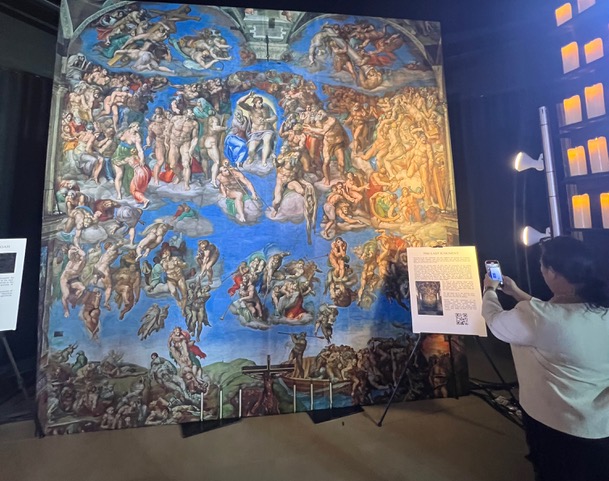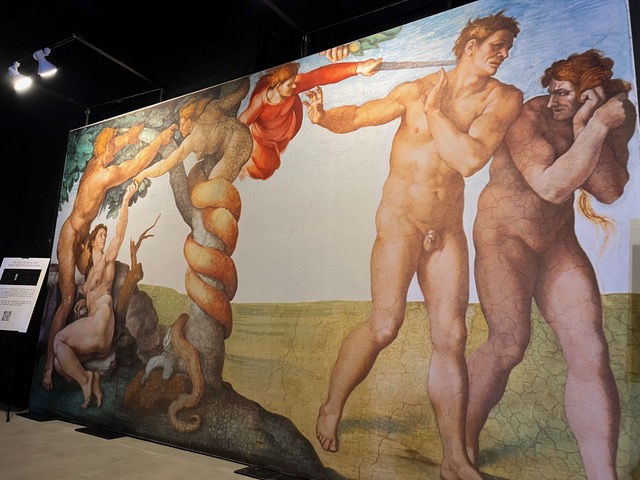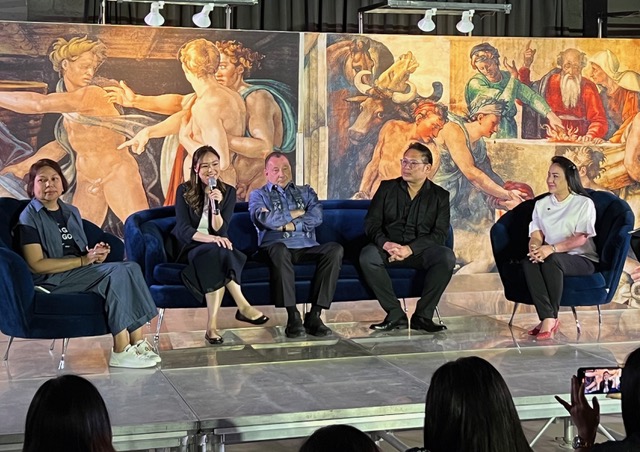The painted scenes on the ceiling of the Vatican’s Sistine Chapel have fascinated me since I received the book “Michelangelo & the Pope’s Ceiling” more than a decade ago. A gift from my then future wife, the 384-page paperback by Ross King recounts the four extraordinary years–from 1508 to 1512—that the genius Michelangelo spent producing the masterpieces.
The frescoes on that 35×14-meter ceiling about six stories from the ground are considered one of the greatest works of art in the world and an important landmark of the Renaissance. (For scale, a basketball court is about 28×15 meters.)
I promised myself that if I ever got the chance to visit the Vatican, I would lay eyes on the 511-year-old art. And I did get the opportunity in October 2012, when I was assigned to cover an automotive event in Rome. But as fate would have it, the line to buy a ticket was impossibly long, and I didn’t want to spend my only free day in a queue.

Eleven years later, I was gazing at true-to-size, high-resolution scans of the paintings, albeit at the second level of Estancia Mall in Ortigas Center, Pasig City. Instead of craning my neck upward, I was standing just inches away from images of the 34 frescoes, which are on 34 huge panels spread all over the venue. It was as if the Sistine Chapel’s ceiling had been taken down section by section, so one can enjoy the art up close. (Michelangelo painted these masterpieces on curved as well as angled surfaces of the ceiling. The reproduced images have been slightly adjusted so they can be presented on the panels’ flat surface.)
With the use of high-definition photography, the paintings were brought to life via a special printing technique that emulates the look and feel of the originals. Visitors may engage with the art in ways never before possible: seeing every detail, brushstroke, and hue. (Frescoes involve painting with water-based paint directly onto wet plaster so that the paint becomes an integral part of the plaster.)
Vatican: Press in denial: Recalling the 2005 conclave that elected Pope Benedict XVI
Closer look

“I wanted to give the public a chance to get a closer look at and immerse themselves in Michelangelo’s art, which is hard to do while visiting the Sistine Chapel,” said Martin Biallas, CEO of SEE Global Entertainment.
“By the time you get inside the Sistine Chapel, you have 15 minutes in and out, and the frescoes are all the way up. And there’s a lot of people. You cannot take any photos at all; they’re very strict about that,” Biallas observed, recalling that time in 2014 when, he said, “I felt like I didn’t have enough time to reflect and appreciate what I was seeing.”

He thought about “getting the licensing rights for the reproductions of the frescoes in their original size” and decided that “it would be a good concept to take.”
SEE Global Entertainment developed the concept for a year before premiering the exhibit at the Palais de Congress in Montreal, Canada, in 2015. It has since taken the exhibit all over the United States, China, Europe and South America.
“What I enjoy most is seeing the reactions of visitors when they first realize how large these pieces are,” Biallas said. “Books don’t do it justice, and even if it is the actual chapel, the artwork is 20 meters above you, so you won’t appreciate the details. Apart from the overcrowding and the noise, there’s the church security rushing you out.”
The exhibit, which opened at Estancia Mall on July 1, is the first in Southeast Asia. it runs until Sept. 20 at 11 a.m.-9 p.m. on weekdays and 10 a.m.-10 p.m. on weekends. Entrance fees are P650 on weekdays and P750 on weekends. There are group passes for six persons at P3,450 and VIP priority tickets, which let holders skip the queue, at P990 each. Tickets may be purchased at the counter or online at sistinechapelphilippines.com (via SM Tickets). Tickets for students, senior citizens, and PWDs are priced at P500 each, but these are only available at the counter.
Multisensory experience

To complete the viewer’s experience, ATIN Scent Marketing has made a unique scent that would take one back to a long-ago time.
“Rose, patchouli, black pepper, fig, and musk—these are among the notes of a 16th-century Renaissance church, and visitors will be able to enjoy the scent throughout the exhibit venue,” said Sabrina Co, founder of ATIN Scent Marketing.
According to Co, she and her family were among the Sistine Chapel exhibit’s first visitors when it opened in Montreal in 2015. She said they were moved by the chance to reconnect with their religious roots, and decided to share the spiritual and educational experience with others in the Philippines.
“The Sistine Chapel is quite significant as it is a religious pinpoint. But not everyone will have the opportunity to travel to the Vatican to see the artworks at the chapel. Through this exhibit here, we are opening up the opportunity for people, including students, to see one of the greatest artworks of all time,” Co said.
Finding the right location was key in staging the exhibit, and Estancia Mall’s 1,000-square-meter space, the minimum space required by the licensor, fits perfectly, Co said. “We considered schools, churches, exhibition halls, museums, but in the end, it made most sense to put it in a shopping mall as Estancia has the space, and the ceiling is sufficiently high,” she said.
There’s music, too, with Marlon Chen of the Manila Symphony Orchestra primarily using a capella sacred music. “I curated the musical tracks so that when you enter, you can be embraced by the music that you’re hearing,” he said.
Licensed by the Vatican

Officially licensed by the Vatican Museums, the exhibit is self-guided, with signages placed beside the panels describing each reproduced artwork and indicating where it is located on the Sistine Chapel’s ceiling. One may also download the app of SEE Global’s Michelangelo’s Sistine Chapel-The Exhibition (via Apple Store or Google Play). By pointing the app to the QR code on the signage, one may be able to listen to an audio guide that tells exactly who is in the painting, why Michelangelo painted it, and its historical significance.
The audio guide runs 90 minutes in its entirety.
Near the entrance, there is also a 20-minute cartoon video that provides fun facts about the four-year process of creating the frescoes. Here, one will learn that Michelangelo was not lying on his back when he was painting because he designed a scaffold that allowed him and his assistants to work standing up. The painting process caused the artist tremendous neck and back strain, and damaged his eyesight.
When the ceiling frescoes turned 500 years old in 2012, the Vatican started limiting visitors to protect one of the wonders of Western civilization and, at the same time, avoid overcrowding. In an article in a Vatican newspaper, a museum official noted: “Pressure caused by humans such as dust introduced, the humidity of bodies, carbon dioxide produced by perspiration not only can cause unease for the visitors. In the long run, they may cause possible damage to the paintings.”
The exhibit is being made possible in partnership with Globe, Philippine Airlines, Department of Tourism, Security Bank, SMDC, Globaltronics, Philippine Red Cross, The Master’s Lighthouse Foundation, and Called To Rescue Philippines.
Part of the proceeds earned from every ticket sale will benefit The Hapag Movement, a Globe-led initiative envisioned to fight involuntary hunger. The project is also aimed, through the Philippine Red Cross, at extending relief and water distribution, sanitation and hygiene activities, and health and welfare services to the families most vulnerable to the eruption of Mayon Volcano.



Leave a Reply